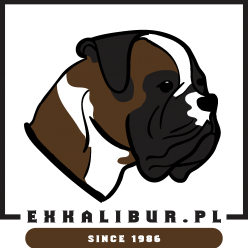Skip to content
- Origin: Germany
- Utilization: Companion, Guard and Working Dog.
- FCI – classification: Group 2 Pinscher and Schnauzer – Molossoid breeds – Swiss Mountain and Cattle Dogs.
- Section 2.1 Molossoid breeds, mastiff type.
- With working trial.
- History: The small, so called Brabant Bullenbeisser is regarded as the immediate ancestor of the Boxer. In the past, the breeding of these Bullenbeissers was in the hands of the huntsmen, whom they assisted during the hunt. Their task was to seize the game put up by the hounds and hold it firmly until the huntsman arrived and put an end to the prey. For this job the dog had to have jaws as wide as possible with widely spaced teeth, in order to bite firmly and hold on tightly. A Bullenbeisser which had these characteristics was best suited to this job and was used for breeding. Previously, only the ability to work and utilization were considered. Selective breeding was carried out which produced a dog with a wide muzzle and an upturned nose.
- General apperance: The Boxer is a medium sized, smooth coated, sturdy dog of compact, square build and strong bone. His muscles are taut, strongly developed and moulded in appearance. His movement is lively, powerful with noble bearing. The Boxer must be neither cumbersome nor heavy, nor light or lacking in body substance.
- Coat:
- Hair: Short, hard, glossy and close fitting.
- Colour: Fawn or brindle.
- Fawn comes in various shades from light fawn to dark deer red but the most attractive shades are in the middle range (red fawn). Black mask.
- The brindle variety: fawn background of varying shades has dark or black stripes running parallel to ribs. Stripes must contrast distinctly to ground colour. White markings should not be discarded. They can be quite pleasant.
- Gait/movement: Lively, full of strength and nobility.
- Size and weight:
- Height at the withers:
- Dogs : 57-63 cm.
- Females : 53-59 cm.
- Weight:
- Dogs: over 30 kg when height at withers is ca 60 cm.
- Bitches : about 25 kg when height at withers is ca 56 cm.
- Faults: Any departure from the foregoing points should be considered a fault and the seriousness with which the fault should be regarded should be in exact proportion to its degree and its effect upon the health and welfare of the dog.
- Behaviour/Temperament: Lack of spirit.
- Head : Lack of nobility and typical expression, sombre face, Pinscher or Bulldog type head. Dribbling, showing of teeth or tongue. Muzzle too pointed or slight. Bridge of nose falling away. Leather or weather nose, pale nose eather. So called, “hawk eye”, lack of pigment in haw. In uncropped ears : Flying, half erect or erect ears, rose ears. Wry jaw, slanting teeth, incorrect position of teeth, poorly developed teeth and unsound teeth due to illness.
- Neck: Short, thick and throaty.
- Body: Front too broad or low to the ground. Sagging body, roach or sway back. Lean, long, narrow, sagging loin, loosely coupled body. Arched loin, croup falling away. Narrow pelvis, hollow flanks, pendulous belly.
- Tail: Low set on, kink tail.
- Forequarters: French front, loose shoulders, loose elbows, weak pastern, hare foot, flat, splayed feet.
- Hindquarters: Weak muscles. Too much or too little angulation, down on hocks, barrel hocks, cow hocks, narrow hocks, dewclaws, hare foot, flat, splayed feet.
- Movement: Waddling, insufficient reach, pacing, stilted
gait.
- Colour of coat: Mask extending beyond muzzle. Stripes (brindling) too close together or too sparse. Sooty ground colour. Mingled colours. Unattractive white markings such as a entirely white head or white on one side of the head. ther colours and white markings exceeding one third of the ground colour.
- Disqualifying faults:
- Aggressive or overly shy.
- Any dog clearly showing physical or behavioural abnormalities shall be disqualified.
- Additional:
- Male animals should have two apparently normal testicles fully descended into the scrotum
- Only functionally and clinically healthy dogs, with breed typical conformation should be used for breeding.
